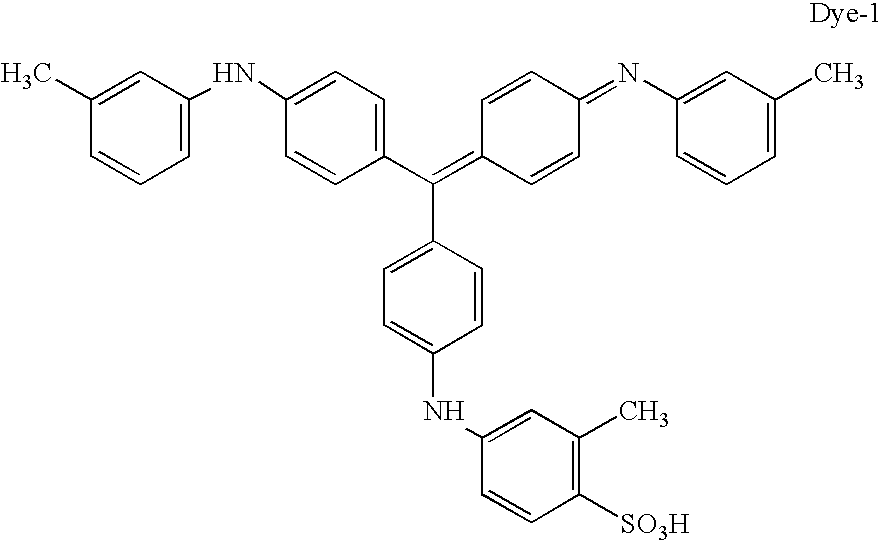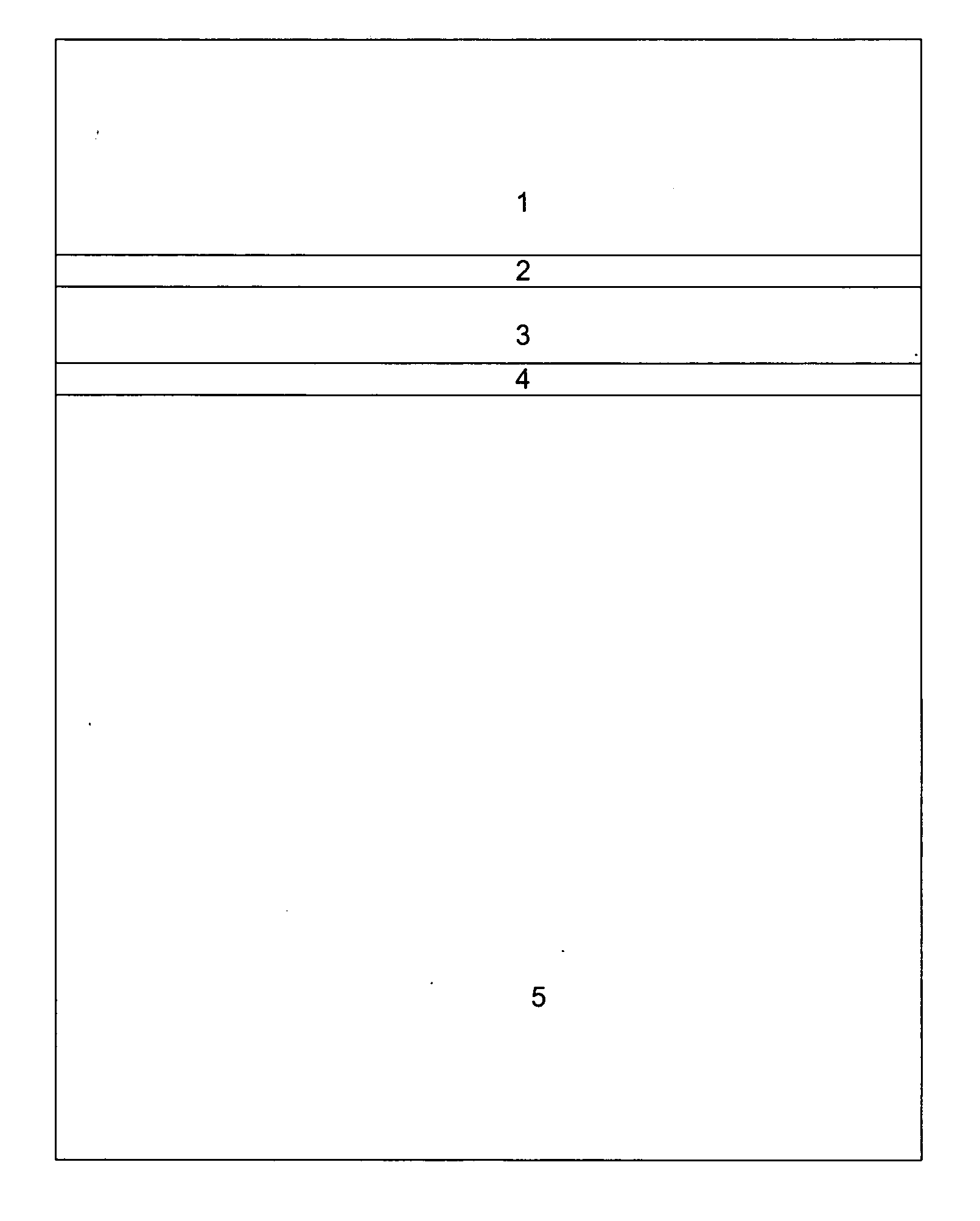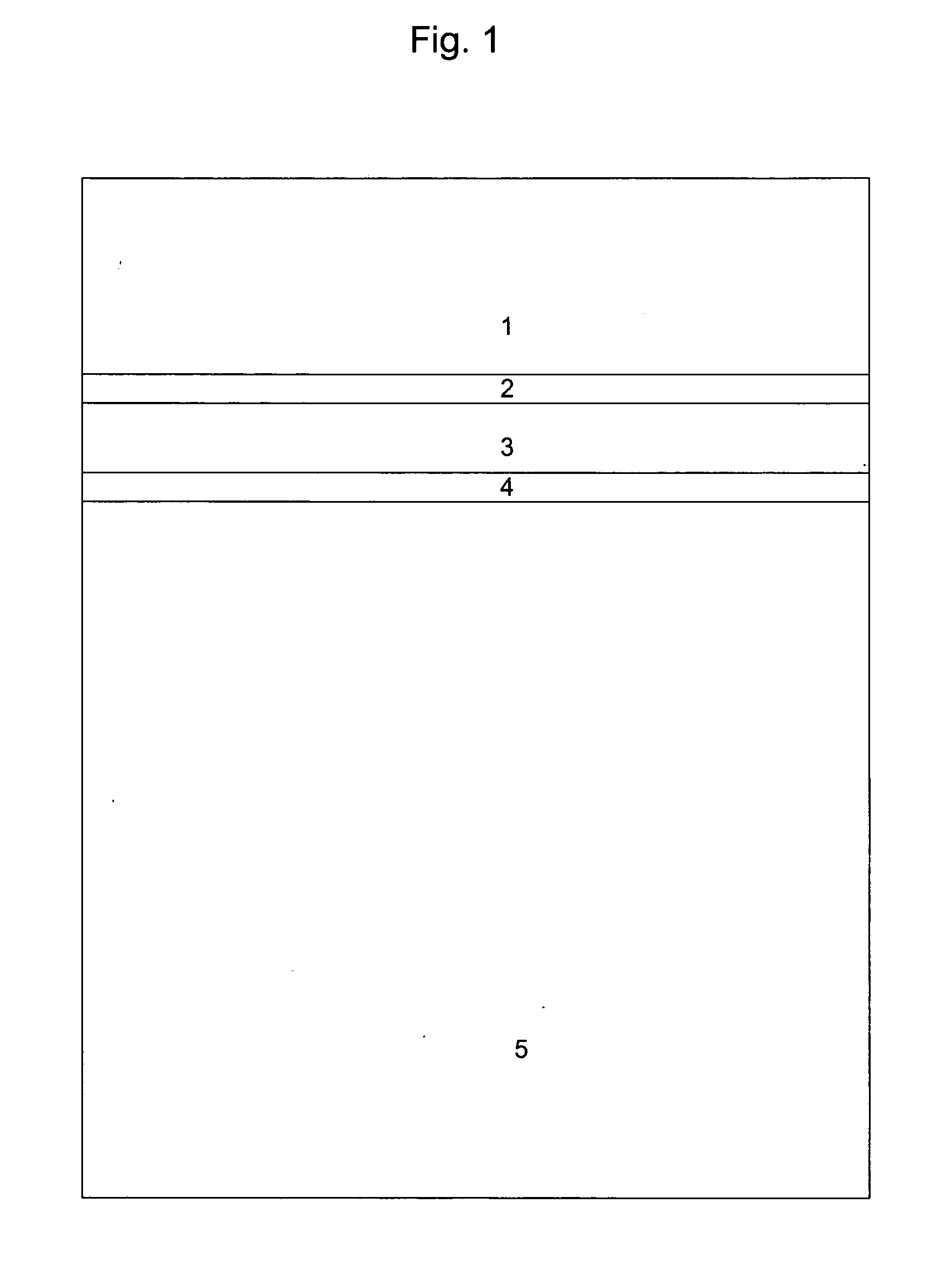[0077] In a further embodiment of the present invention the package of the packed screen or panel according to the present invention is provided with an antistatic
coating on at least one side of the (multilayered) foil. More preferably such an antistatic layer is provided on the inner
thermoplastic polymer layer and / or the outer
layers of the storage panels, as removal of the
storage phosphor panels from the package may lead to charging / discharging phenomena of
static electricity, although the
aluminum foil is electroconductive and may reduce (in part) disadvantageous effects, depending on the environmental circumstances. More particularly in a "dry"
atmosphere wherein a low
relative humidity is measured, the problem may be stringent.
[0078] Moreover the aluminum layer forms a surface with a highly reflective power whereby absorption of IR
radiation by the package and
resultant heating of the contents is minimized.
[0079] In the optional embodiment wherein one or more antistatic layer(s) is(are) present onto the thermoplastic layer of the foil and / or on outer
layers of the storage panels, it has to be recommended to make use of an
antistatic agent or agents in the coated layer formulations in order to obtain the smallest possible tribo-electrical differences between the antistatic layer and the outer
layers of the storage panels that are in direct contact with each other. So coating compositions comprising the same
antistatic agent(s) may be applied both on the
thermoplastic polymer layer and on (or in) the protective outer layer(s) of the storage phosphor panels. As antistatic agents water-soluble conductive polymers may be used having at least one conductive group selected from a sulphonic
acid group, a sulphate-group, a
phosphate-group, a
quaternary ammonium salt group, a
tertiary sulfonium salt group, a carboxyl group and a polyoxyethylene group. The conductive group may be linked directly to the polymer, through a
divalent coupling group or to an aromatic, heterocyclic ring as e.g. a
benzene ring or a
pyridine ring. The conductive polymers may further include at least one of the group selected from
styrene, vinylidene
chloride,
acrylic acid,
methacrylic acid,
itaconic acid, itaconic esters or butadiene. The most useful polymers for embodying the invention are generally those having an average molecular weight of about 10 to 10.sup.6. In the outer protective layers amounts of
conductive polymer expressed in
solid matter varying from 0.0001 to 10 g / m.sup.2 may be added and, more preferably, from 0.001 to 1 g / m.sup.2. Instead of or in addition to conductive polymers, the antistatic layers may comprise antistatic compounds. Especially preferred antistatic compounds are fluorinated compounds, in particular fluorinated surfactants, like e.g. perfluorocaprilic acid or its salts and
hydrophilic polymers with polyoxyethylene units and a terminal fluorinated group. Preferred fluorinated compounds for use in packed storage screens
assembly according to the present invention are those having a group with oxyethylene groups, represented by the formula RF--A--X, wherein RF stands for a partly or wholly fluorinated
hydrocarbon chain comprising at least 3
fluorine atoms, A stands for a
chemical bond, a bivalent
hydrocarbon group including a bivalent
hydrocarbon group interrupted by one or more heteroatoms, or the group --COO, --CON(R)--, --SO.sub.2N(R)-- or SO.sub.2N(R)CO wherein R is
hydrogen or
alkyl comprising from 1 to 5 C-atoms, X stands for a hydrophilic oxyalkylene group containing one or more oxyethylene groups.
[0080] Further any of the generally known
polyethylene oxide polymers may be useful as an
antistatic agent: a preferred antistatic agent is a
polyethylene oxide compound, represented as R--O--(CH.sub.2CH.sub.2O).sub-.n--H in general, wherein n is an integer of at least 4 preferably between 8 and 30 and R represents a
long chain alkyl or alkylaryl group having at least 10 C-atoms as e.g. oleyl. Different antistatic agents as described hereinbefore may be present as mixtures in the antistatic layer(s) in this invention, the mixtures being the same or different for the different antistatic layers. Antistatic layers may further contain a latex. Such latexes, if present, preferably contain an
acrylate or a
methacrylate component esterified with an
alkyl group in the polymer molecules thereof. Examples of such latex components include e.g.
methyl acrylate,
ethyl acrylate,
butyl acrylate,
methyl methacrylate, ethyl
methacrylate and
butyl methacrylate.
[0081] Methods of coating packages described hereinbefore with at least one antistatic coating layer are well-known from the state-of-the-art. Said at least one antistatic coating may be applied to the heat sealable
thermoplastic polymer for use as inner layer of the packed storage phosphor screen of the present invention by means of roller coating, slide-hopper coating,
curtain coating,
spray coating or, and preferably, by gravure printing. On top of the outer layers of the storage panels at least one antistatic layer may be applied e.g. by means of preferred
spray coating techniques. Alternatively at least one antistatic agent may be added to said outer layers of the storage panels layer.
[0082] By making use of storage phosphor panels separately packed with a thermoplastic wrapper having an antistatic layer, wherein the storage panels and the thermoplastic wrapper are in intimate contact, the problems caused by
static charges prior to use by removal of a storage panel out of its package material can be avoided or substantially reduced. In the alternative the wrapper described above, if present, may be covered or may have included therein an effective amount of a conductive compound lowering the lateral electrical resistance. A particular conductive compound suitable for use therein is a
polythiophene compound. Said
polythiophene compound, if present, is preferably incorporated in an antistatic layer(s) as an
aqueous dispersion of a
polythiophene compound / polymeric anion complex and in a preferre embodiment said polymeric anion is
polystyrene sulphonate. The thus applied polythiophene conductive compound providing ability to reduce a lateral electrical resistance up to a level of less than 10.sup.11
Ohm per square preferably is
polyethylene dioxythiophene (PEDT). In the alternative the said conductive compound is a member chosen from the group consisting of
tin oxide,
indium tin oxide, and
vanadium oxide or a member chosen from the group consisting of
polyaniline, a tetracyanoquinone (TCNQ) complex, a
quaternary ammonium compound, and a sulphonated compound. In a preferred embodiment said compound or said mixture of compounds is, or comprises a perfluorinated surfactant, wherein the layer pack of the packaging materials comprises an
adhesive layer and a rigid polymeric resin, expressed in an alternative way as comprising a coated soft polymeric layer and a coated hard polymeric layer. Polymeric layer(s) may, besides an antistatic layer as explained above, further contain a matting agent in order to avoid undesired slidability, in favor of manutention. As a matting agent, PMMA is preferred. In a further particular embodiment, said antistatic layer(s) further contain(s) an anti-scratch agent. In a preferred embodiment said anti-scratch agent is a polysiloxane-polyether
copolymer.
 Login to View More
Login to View More 


